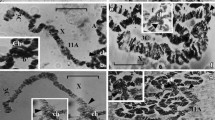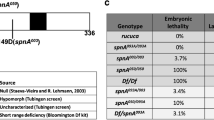Abstract
The sbrgene of Drosophila melanogasterbelongs to the NXF(nuclear export factor) family responsible for the mRNA transport from nucleus to cytoplasm. We have shown that in the heat-exposed (37°C, 1 h) females, the l(1)ts403(sbr 10) mutation leads, in particular, to the high-frequency nondisjunction and loss of sex chromosomes in meiosis. For this trait, the incomplete dominance of the sbr 10 mutation is observed. At the same time, the sbr 10 mutation is recessive for many other traits of the heat-exposed flies: reduced viability, low fertility, impaired synthesis of the heat shock proteins, etc. The females heterozygous for the null allele (Df(1)v L4, a deletion eliminating gene srb) do not differ from females homozygous for the wild-type allele in frequency of the heat shock-induced nondisjunction and loss of sex chromosomes in meiosis. Because of this, the sbr 10 mutation can be assigned to the gain-of-function alleles (those gaining the dominance function). Expression of the mutant sbr 10 allele against the background of the wild-type allele suggests that in the heat shock-exposed females, the heat-modified product of this ts allele has an active effect on sex chromosome disjunction in meiosis.
Similar content being viewed by others
References
Segref, A., Sharma, K., Doye, V., et al., Mex67p, a Novel Factor for Nuclear mRNA Export, Binds to Both Poly(A)+RNA and Nuclear Pores, EMBO J., 1997, vol. 16, no. 11, pp. 3256-3271.
Hurt, E., Sträßer, K., Segref, A., et al., Mex67p Mediates Nuclear Export of a Variety of RNA Polymerase II Transcripts, J. Biol. Chem., 2000, vol. 275, no. 12, pp. 8361-8368.
Tan, W., Zolotukhin, A.S., Bear, J., et al., The mRNA Export in Caenorhabditis elegans Is Mediated by Ce-NXF-1, an Ortholog of Human TAP/NXF and Saccharomyces cerevisiae Mex67p, RNA, 2000, vol. 6, no. 12, pp. 1762-1772.
Grüter, P., Tabernero, C., von Kobbe, C., et al., TAP, the Human Homologue of Mex67p, Mediates CTE-Dependent RNA Export from the Nucleus, Mol. Cell, 1998, vol. 1, no. 5, pp. 649-659.
Kang, Y. and Cullen, B.R., The Human TAP Protein Is a Nuclear mRNA Export Factor That Contains Novel RNA-Binding and Nuclear Cytoplasmic Transport Sequence, Genes Dev., 1999, vol. 13, no. 9, pp. 1126-1139.
Sträßer, K. and Hurt, E., Nuclear RNA Export in Yeast, FEBS Lett., 1999, vol. 452, nos. 1-2, pp. 77-81.
The FlyBase Database of the Drosophila Genome Projects and Community Literature, Nucleic Acids Res., 1999, vol. 27, no. 1, pp. 85-88.
Evgen'ev, M.B. and Levin, A.V., The Effect of a ts Mutation on the Expression of Heat Shock-Inducible Genes in Drosophila melanogaster: 1. Analysis of Protein Synthesis, Genetika (Moscow), 1980, vol. 16, no. 6, pp. 1026-1029.
Levin, A.V., Lozovskaya, E.R., and Evgen'ev, M.B., The Effect of High Temperatures on the Expression of the Heat Shock-Inducible Genes in Drosophila melanogaster: 2. Analysis of the Effect of a ts Mutation, Genetika (Moscow), 1984, vol. 20, no. 6, pp. 949-953.
Mamon, L.A., Mazur, E.L., Churkina, I.V., and Barabanova, L.V., The Effect of a High Temperature on Frequencies of Nondisjunction and Loss of the Sex Chromosomes in Drosophila melanogaster l(1)ts403 Females Defective in the Heat-Shock Protein System, Genetika (Moscow), 1990, vol. 26, no. 3, pp. 554-556.
Mamon, L.A., Bondarenko, L.V., and Tretyakova, I.V., et al., The Consequences of Cell Stress in Drosophila with Disturbed Synthesis of Heat-Shock Proteins, Vestn. St.-Petersb. Univ., Ser. 3, 1999, issue 4, no. 24, pp. 100-114.
Kutskova, Yu.A. and Mamon, L.A., The Consequences of Extreme Effects on Drosophila melanogaster Somatic Cells with Disturbed Synthesis of Heat-Shock Proteins, Genetika (Moscow), 1996, vol. 32, no. 10, pp. 1406-1416.
Mamon, L.A. and Kutskova, Yu.A., The Role of Heat-Shock Proteins in Restoration of Cell Proliferation in D. melanogaster Larvae Exposed to a High Temperature, Genetika (Moscow), 1993, vol. 29, no. 5, pp. 791-798.
Mamon, L.A., Nikitina, E.A., Golubcova, E.V., and Pugachova, O.M., Heat Shock Induced Cellular and Early Embryonic Death in Drosophila melanogaster ts-Mutant Strain, Pathophysiology, 1998, vol. 5, suppl. 1, p. 9.
Tretyakova, I.V., Lezin, G.T., Markova, E.G., et al., The Drosophila melanogaster sbr Gene Product and Its Yeast (Mex67p) and Human (TAP) Orthologs, Genetika (Moscow), 2001, vol. 37, no. 6, pp. 725-736.
Arking, R., Temperature-Sensitive Cell-Lethal Mutants of Drosophila: Isolation and Characterization, Genetics, 1975, vol. 80, no. 3, pp. 519-537.
Zhimulev, I.F., Semeshin, V.F., Kochneva, G.V., et al., A Cytogenetic Study of Region 9E-10A of the Drosophila melanogaster X-Chromosome: IV. Construction and Characterization of Chromosome Rearrangements in the ras-dsh Region, Genetika (Moscow), 1982, vol. 18, no. 4, pp. 596-612.
Bourguet, D. and Raymond, M., The Molecular Basis of Dominance Relationships: The Case of Some Recent Adaptive Genes, J. Evol. Biol., 1998, vol. 11, pp. 103-122.
Sprenger, F., Stevens, L.M., and Nüsslein-Volhard, C., The Drosophila Gene torso Encodes a Putative Receptor Tyrosine Kinase, Nature, 1989, vol. 338, no. 6215, pp. 478-483.
Lansbury, P.T., Evolution of Amyloid: What Normal Protein Folding May Tell Us about Fibrillogenesis and Disease, Proc. Natl. Acad. Sci. USA, 1999, vol. 96, no. 7, pp. 3342-3344.
Smith, D.F., Whitesell, L., and Katsanis, E., Molecular Chaperones: Biology and Prospects for Pharmacological Intervention, Pharmacol. Rev., 1998, vol. 50, no. 4, pp. 493-513.
Schneuwly, S., Kuroiwa, A., and Gehring, W.J., Molecular Analysis of the Dominant Homeotic Antennapedia Phenotype, EMBO J., 1987, vol. 6, pp. 201-206.
Gibson, G. and Gehring, W.J., Head and Thoracic Transformations Caused by Ectopic Expression of Antennapedia during Drosophila Development, Development (Cambridge, UK), 1988, vol. 102, pp. 657-675.
Mamon, L.A., Komarova, A.V., Bondarenko, L.V., et al., Development of Thermotolerance in Drosophila melanogaster Strain l(1)ts403 with Disturbed Synthesis of Heat-Shock Proteins, Genetika (Moscow), 1998, vol. 34, no. 7, pp. 920-928.
King, R.C. and Burnett, R.G., Autoradiographic Study of Uptake of Tritiated Glycine, Thymidine, and Uridine by Fruit Fly Ovaries, Science, 1959, vol. 129, pp. 1674-1675.
Huettner, A.F., Maturation and Fertilization in Drosophila melanogaster, J. Morphol., 1924, vol. 39, pp. 249-265.
Callaini, G. and Riparbelli, M.G., Fertilization in Drosophila melanogaster: Centrosome Inheritance and Organization of the First Mitotic Spindle, Dev. Biol., 1996, vol. 176, no. 2, pp. 199-208.
Tretyakova, I.V., Molecular Genetic Analysis of a Drosophila melanogaster DNA Region Containing the Vital l(1)ts403 Gene, Cand. Sci. (Biol.) Dissertation, St. Petersburg: St. Petersburg State Univ., 2000.
Wilkie, G.S., Zimyanin, V., Kirby, R., et al., Small bristles, the Drosophila Ortholog of NXF-1, Is Essential for mRNA Export throughout Development, RNA, 2001, vol. 7, no. 12, pp. 1781-1792.
Evgen'ev, M.B. and Denisenko, O.N., The Effect of a ts Mutation on the Expression of the Heat Shock-Inducible Genes in Drosophila melanogaster: 3. Synthesis of HSP70-Related Proteins, Genetika (Moscow), 1990, vol. 26, no. 2, pp. 266-271.
Cummings, M. and King, R., The Cytology of the Vitellogenetic Stages of Oogenesis in Drosophila melanogaster, J. Morphol., 1969, vol. 128, pp. 427-442.
Edgar, B.A. and Schubiger, G., Parameters Controlling Transcriptional Activation during Early Drosophila Development, Cell (Cambridge, Mass.), 1986, vol. 44, no. 6, pp. 871-877.
Bashirullah, A., Cooperstock, R.L., and Lipshitz, H.D., RNA Localization in Development, Annu. Rev. Biochem., 1998, vol. 67, pp. 335-394.
Lipshitz, H.D. and Smibert, C.A., Mechanisms of RNA Localization and Translational Regulation, Curr. Opin. Genet. Dev., 2000, vol. 10, no. 5, pp. 476-488.
Yoon, D.W., Lee, H., Seol, W., et al., Tap: A Novel Cellular Protein That Interacts with Tip of Herpesvirus Saimiri and Induces Lymphocyte Aggregation, Immunity, 1997, vol. 6, no. 5, pp. 571-582.
Jung, J.U., Lang, S.M., Jun, T., et al., Downregulation of Lck-Mediated Signal Transduction by Tip of Herpesvirus Saimiri, J. Virol., 1995, vol. 69, no. 12, pp. 7814-7822.
Coakley, T., Hyperthermia Effects on the Cytoskeleton and on Cell Morphology, Temperature and Animal Cells: Symp. Soc. Exp. Biol., 1987, no. 41, pp. 187-211.
Laszlo, A., The Effects of Hyperthermia on Mammalian Cell Structure and Function, Cell Prolif., 1992, vol. 25, no. 2, pp. 59-87.
Heald, R., Tournebize, R., Blank, T., et al., Self-Organization of Microtubules into Bipolar Spindles around Artificial Chromosomes in Xenopus Egg Extracts, Nature, 1996, vol. 382, no. 6590, pp. 420-425.
Korey, C.A., Wilkie, G.S., Davis, I., and Van Vactor, D., Small bristles, DmNXF1, Is Required for the Morphogenesis of Multiple Tissues during Drosophila Development, Genetics, 2001, vol. 159, no. 4, pp. 1659-1670.
Herold, A., Suyama, M., Rodrigues, J.P., et al., TAP (NXF1) Belongs to a Multigene Family of Putative RNA Export Factors with a Conserved Modular Architecture, Mol. Cell. Biol., 2000, vol. 20, no. 23, pp. 8996-9008.
Author information
Authors and Affiliations
Rights and permissions
About this article
Cite this article
Nikitina, E.A., Komarova, A.V., Golubkova, E.V. et al. Semidominant Effect of the l(1)ts403 (sbr 10) Mutation on Sex Chromosome Nondsjunction in Meiosis in Drosophila melanogaster Females Exposed to Heat. Russian Journal of Genetics 39, 269–275 (2003). https://doi.org/10.1023/A:1023208725228
Issue Date:
DOI: https://doi.org/10.1023/A:1023208725228




